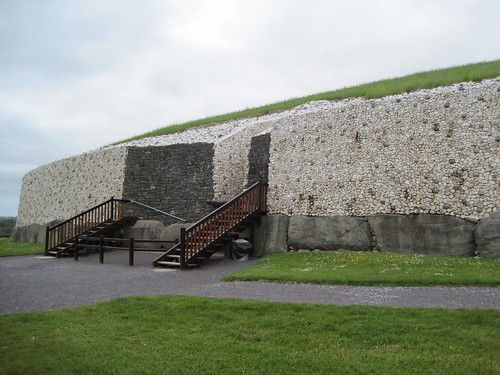Occurred 6/1/10; written 6/2/10
Newgrange was awesome.
Our second coach tour of Ireland was a lot better than our first, in my opinion. I’ll be the first to admit I wasn’t so excited about Newgrange after the Wicklow tour.
My hesitation was quickly laid to rest thanks to our driver, Brien, who made me feel at home right away because he reminded me of my next-door neighbor, Curly. Both of these individuals have a lot of knowledge and are not afraid to share it with anybody willing to listen. I initially thought Brien might have been taking us on another city tour after we saw a lot of landmarks in City Centre that we’d already seen on last week’s coach tour, but he eventually hauled us all out of Dublin and safely to Newgrange.
Constructed by Neolithic people near the River Boyne over 5,000 years ago, Newgrange is older than the Egyptian pyramids by around a thousand years and England’s Stonehenge by 500 years. The roof, as our tour guide John told us, is made up only of stone and has not leaked a single drop of water since the building was created. The people at that time averaged a height of 4’11”, so the walkway into the center was very cramped. I saw at least two people bump their heads on the way out, despite the lady at the end saying not to stand up until turning the corner to exit.
Newgrange is mysterious for a lot of reasons. Like Stonehenge, nobody is certain of exactly how the tomb was created. My main impression after the introductory video was that it wasn’t so much a tomb, but a way for farmers to tell when the ground would be ready for planting – i.e., an observatory. During the days around the winter solstice, sunlight shines in a hole in the entrance to light up the inside. John showed us a replication of what the lit-up inside of Newgrange looked like, but admitted the 40-watt bulb was a poor version of the actual sun. I asked John if the ancient Irish used fires to see the inside, but he said there was no evidence of it.
Markings inside and outside Newgrange have been lost in translation since nobody thought to preserve it until a few hundred years ago. John specifically called out the tri-spiral, which he said might have indicated the Neolithics had some religious beliefs. Each of the three spirals form together in the middle, and John’s theory was that the ancients had an idea of birth, death, and rebirth. He thought nobody would be buried unless that person’s mortal body could find some kind of second life. If this theory is true, the thought of an afterlife has to predate Christ.
John was an excellent guide for Newgrange and I’m really happy to have seen it. I would have to rate it as one of my top three experiences in Ireland.


